Msrtia: A proposal to reduce the response time for load balancing on cloud computing
Abstract: Cloud computing is a model that provides
everything related to information technology in the form
of services through the Internet. The primary benefit of it
is to save the original system investment cost, optimize
the data processing, calculating and storing data.
Nowadays, cloud computing faces many challenges in
ensuring the quality of service throughout. In which the
problem of overloading physical servers or virtual servers
of data centres is concerned specially. So as to qualify the
above requests, setup an effective load balancing method
and using resources with the most optimization is the
target which cloud computing wants to gain. In this paper,
we propose Max-Min Scheduling Response Time
Improved Algorithm (MSRTIA) basing on Max Min
Scheduling algorithm. Our algorithm calculates the
Cloudlet aggregation value of requests then pairs the
request with the largest value found with the fastest
executing virtual machine (VM). In which, Cloudlet
aggregation value is the association of length, output size
and file size parameters. The simulation result proves that
MSRTIA has less response time in comparison with MaxMin Scheduling and Round-Robin algorithms.
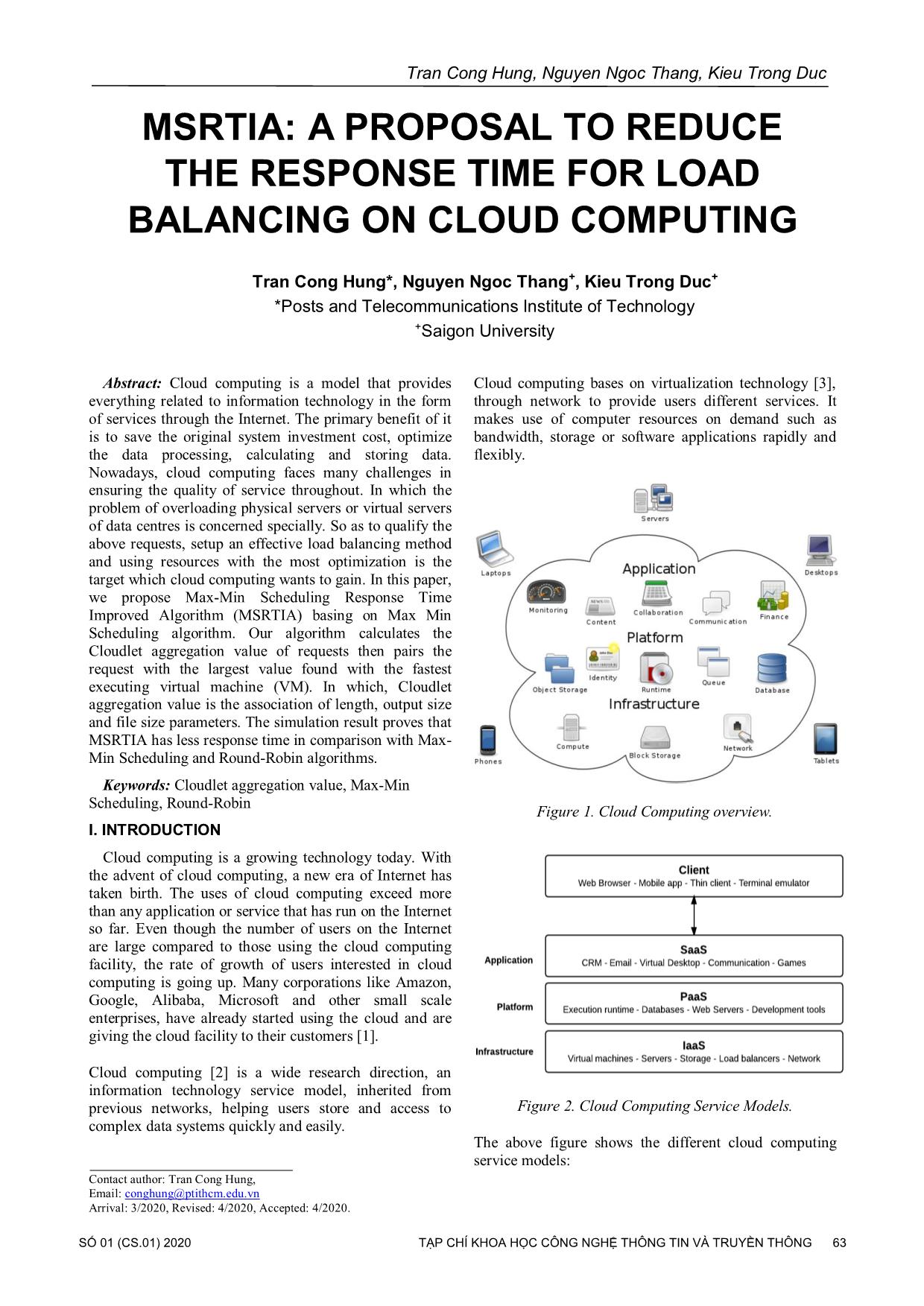
Trang 1
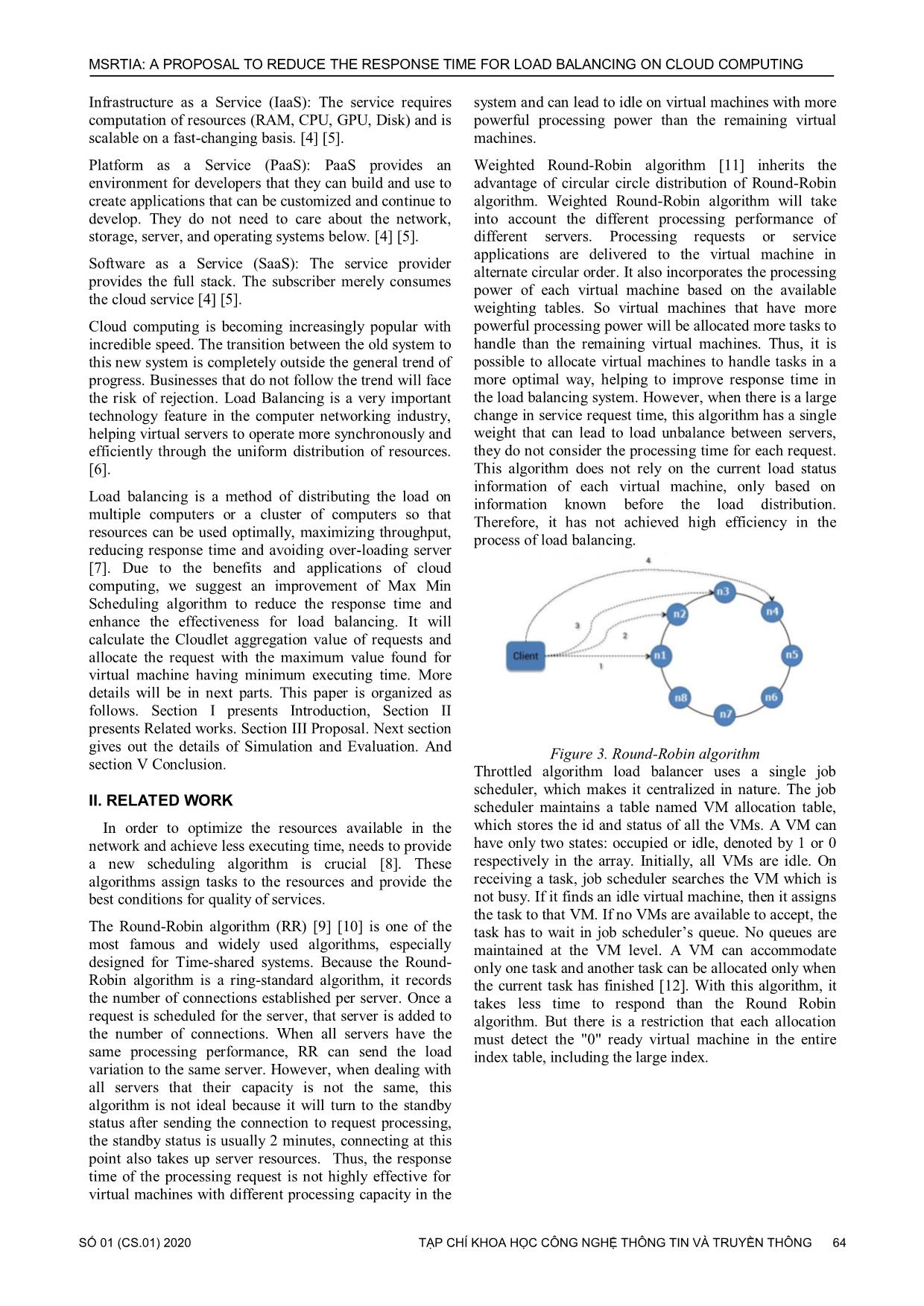
Trang 2
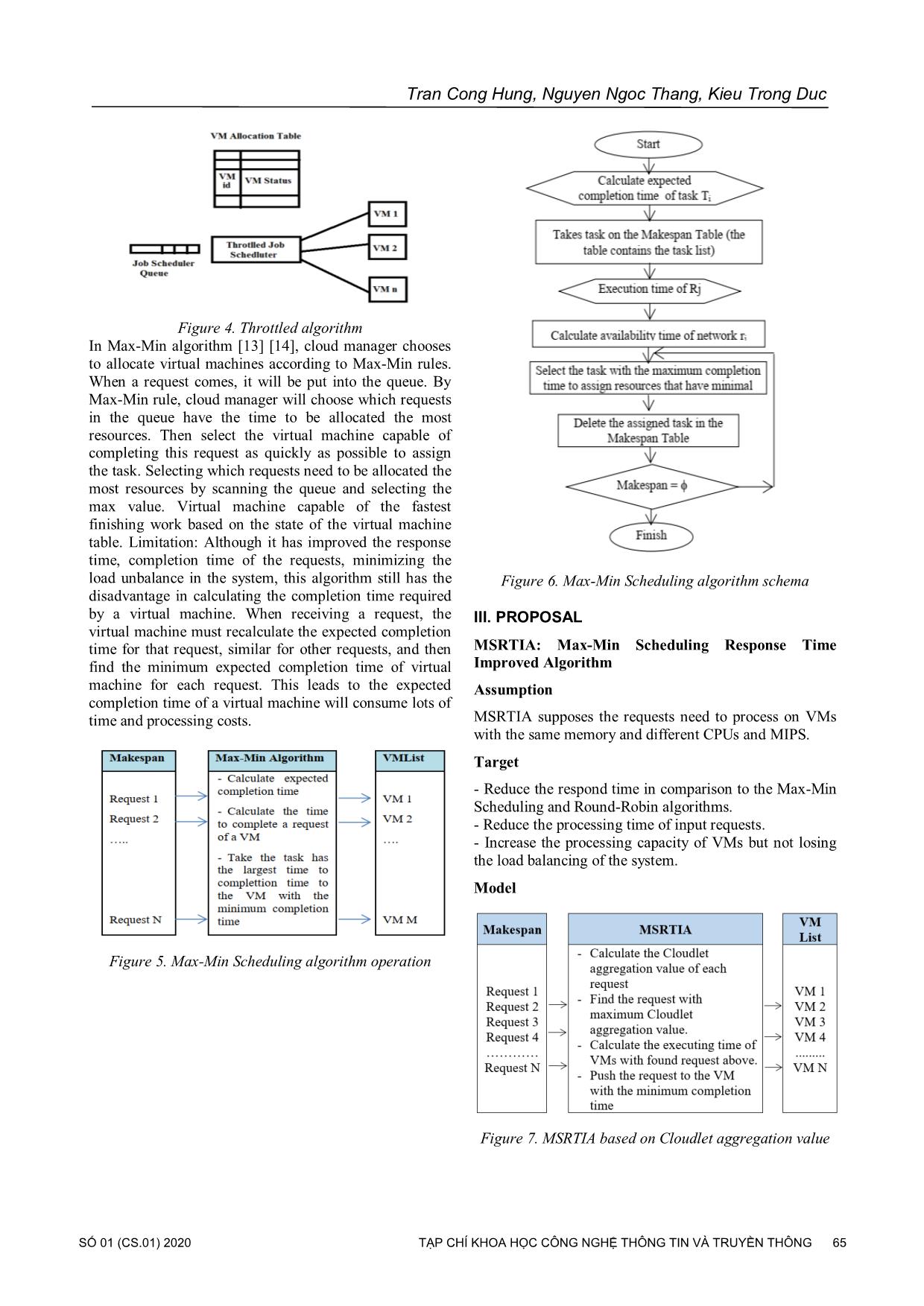
Trang 3
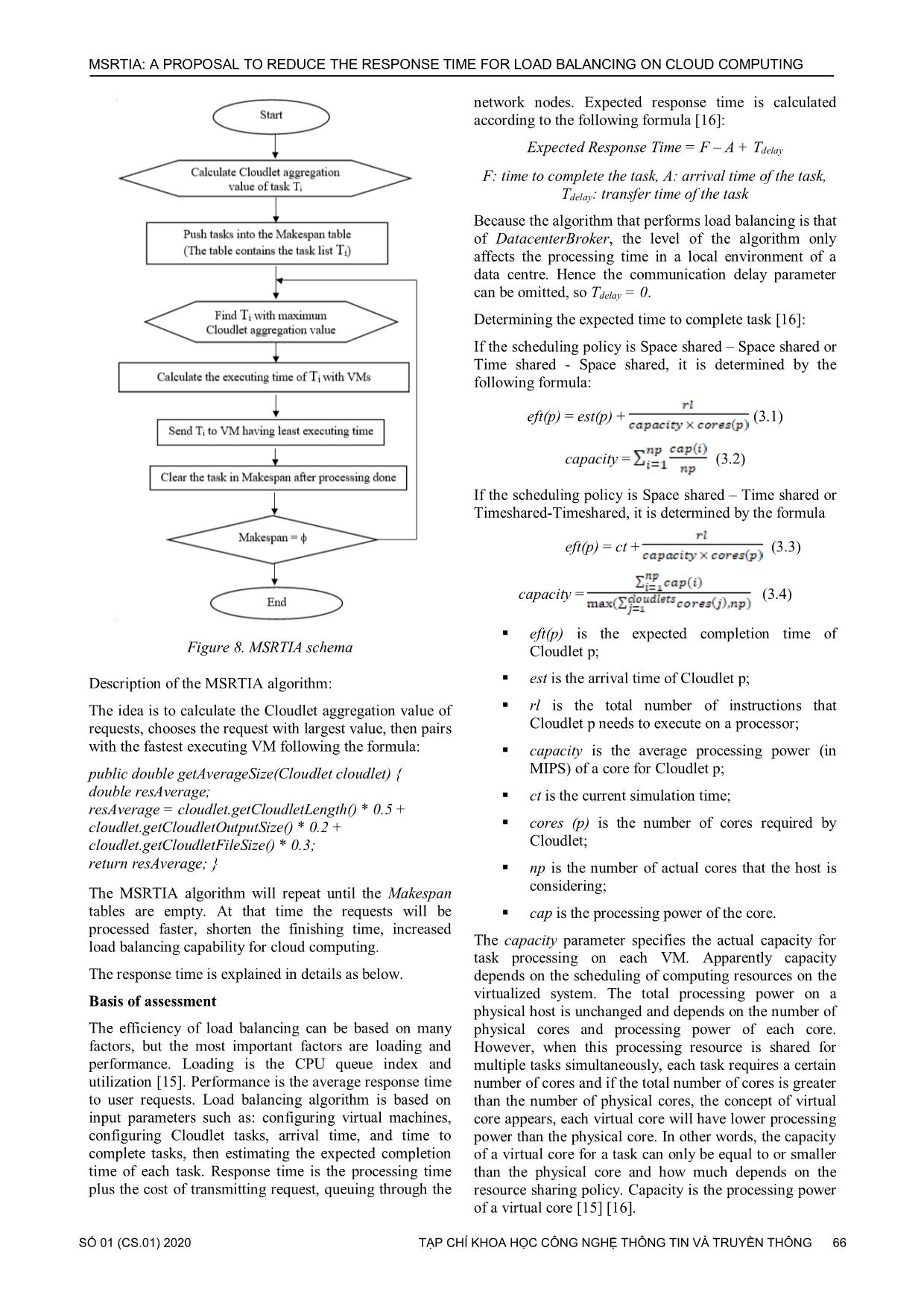
Trang 4
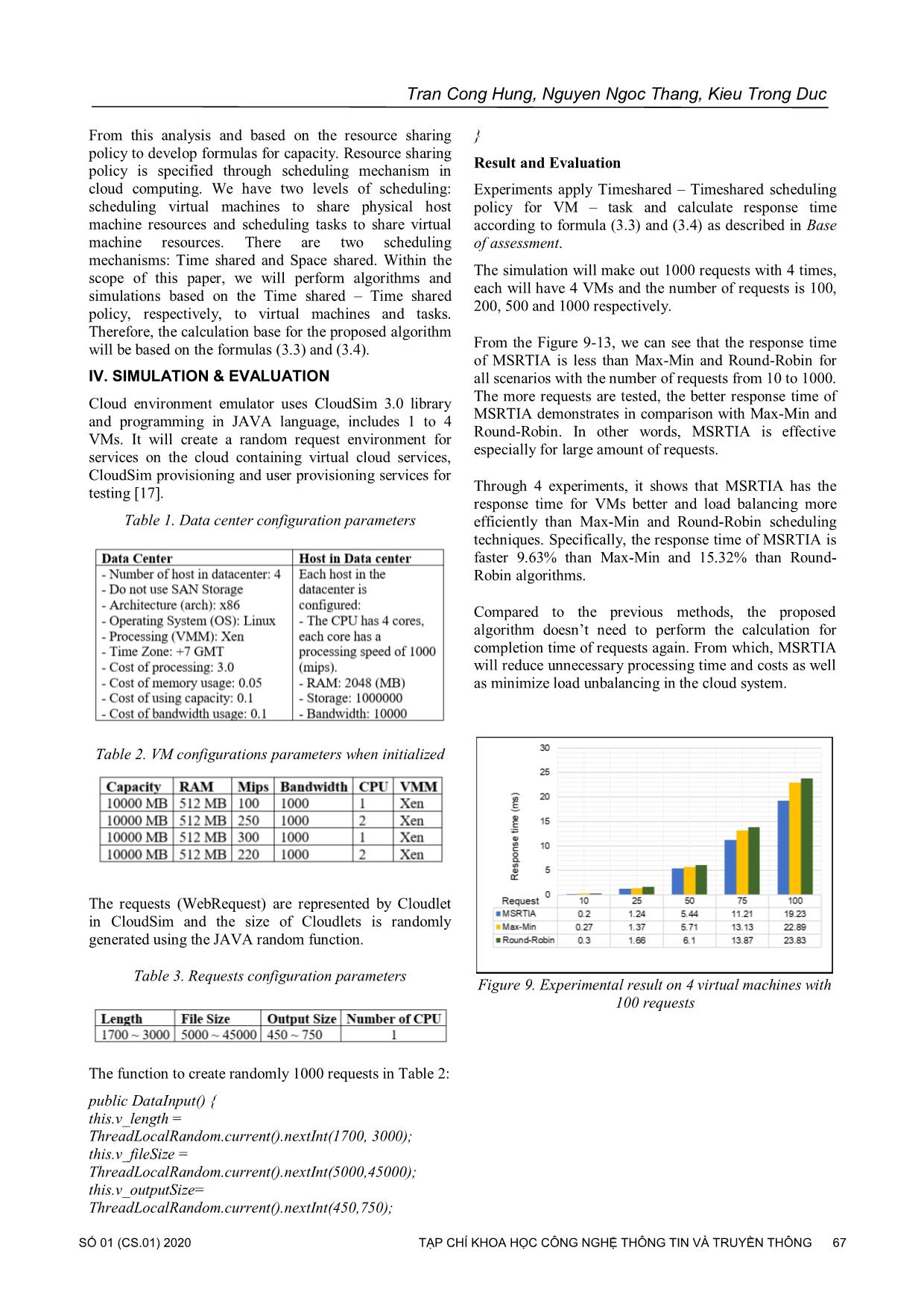
Trang 5
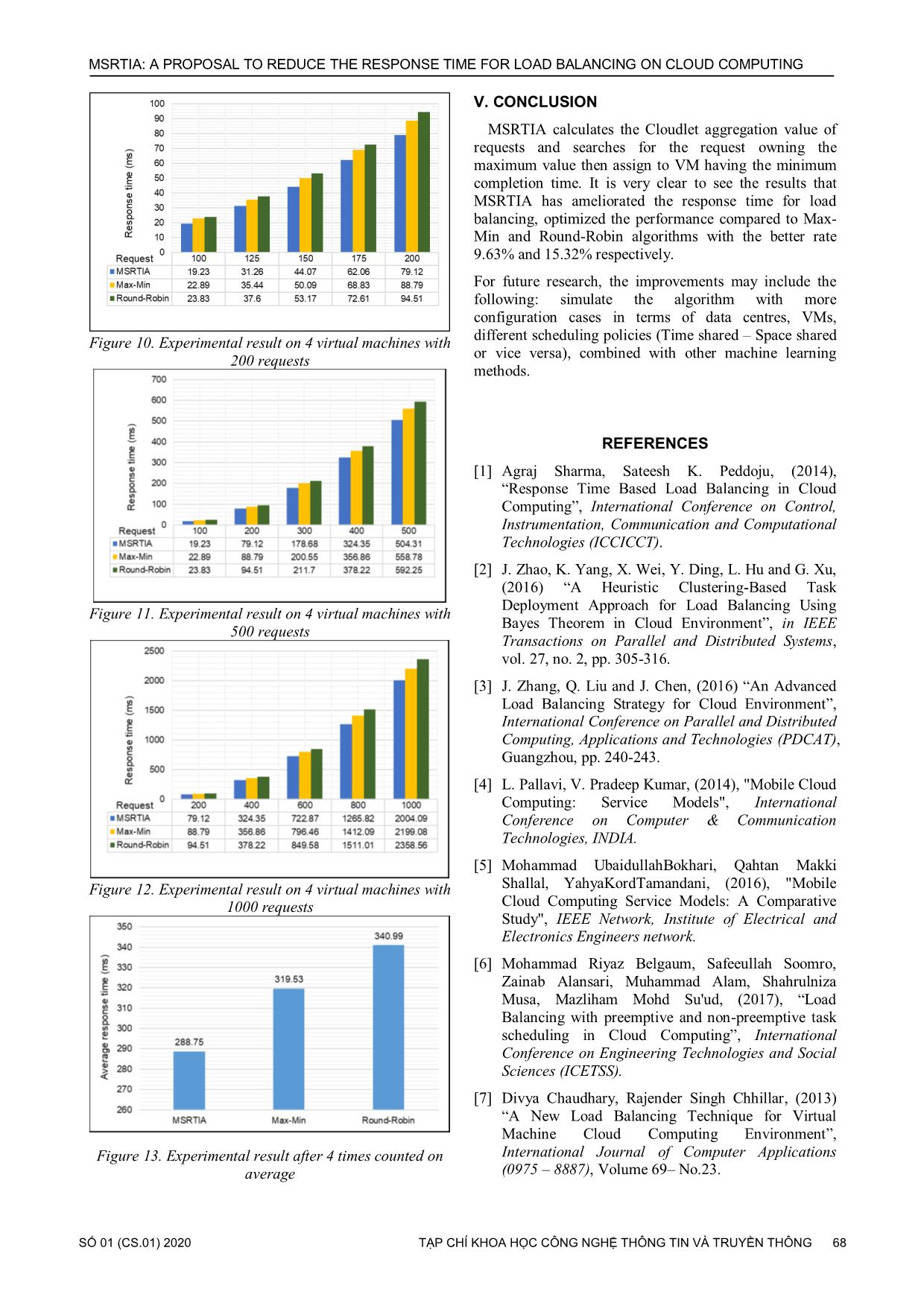
Trang 6
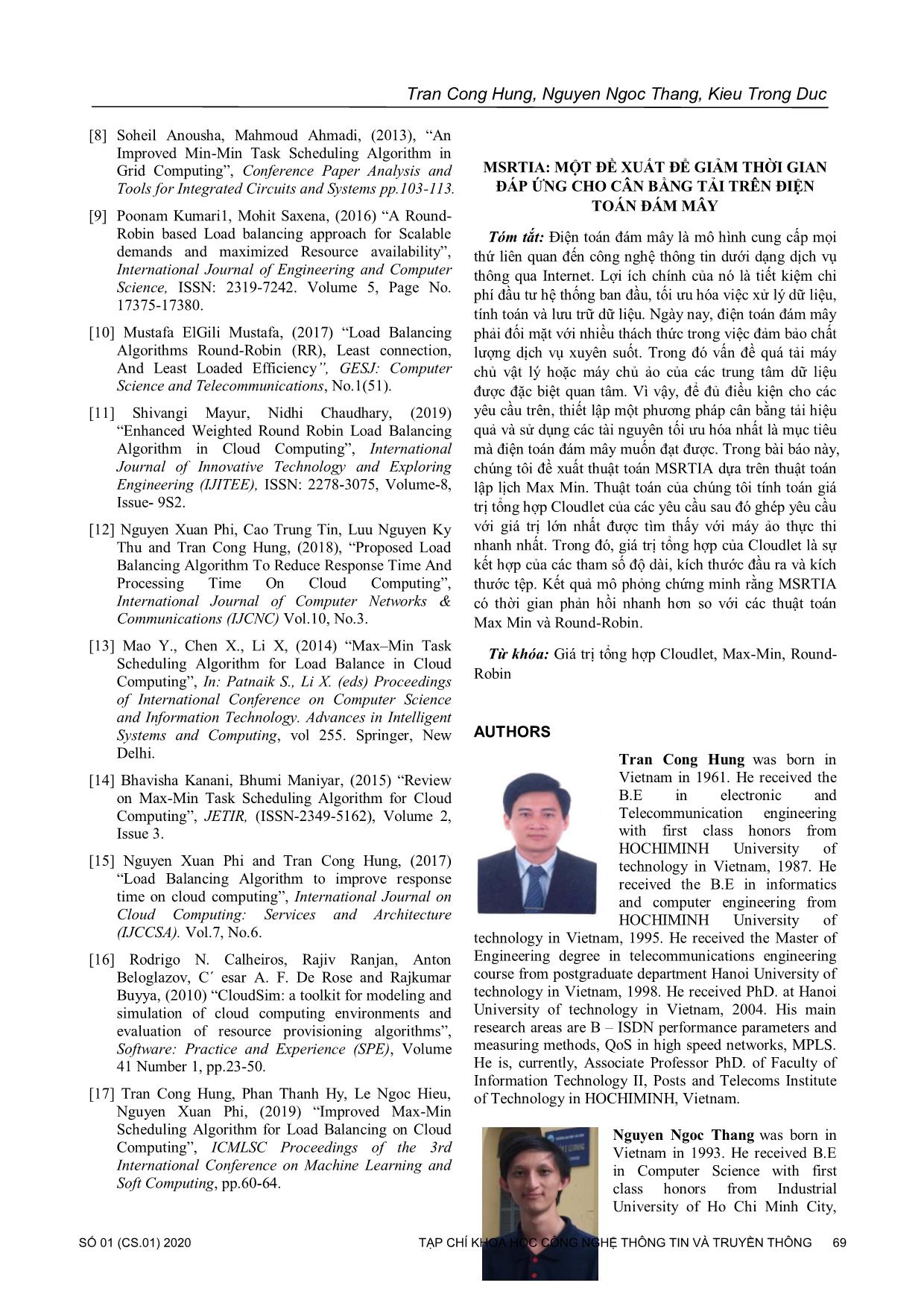
Trang 7

Trang 8
Tóm tắt nội dung tài liệu: Msrtia: A proposal to reduce the response time for load balancing on cloud computing

E RESPONSE TIME FOR LOAD BALANCING ON CLOUD COMPUTING
Figure 8. MSRTIA schema
Description of the MSRTIA algorithm:
The idea is to calculate the Cloudlet aggregation value of
requests, chooses the request with largest value, then pairs
with the fastest executing VM following the formula:
public double getAverageSize(Cloudlet cloudlet) {
double resAverage;
resAverage = cloudlet.getCloudletLength() * 0.5 +
cloudlet.getCloudletOutputSize() * 0.2 +
cloudlet.getCloudletFileSize() * 0.3;
return resAverage; }
The MSRTIA algorithm will repeat until the Makespan
tables are empty. At that time the requests will be
processed faster, shorten the finishing time, increased
load balancing capability for cloud computing.
The response time is explained in details as below.
Basis of assessment
The efficiency of load balancing can be based on many
factors, but the most important factors are loading and
performance. Loading is the CPU queue index and
utilization [15]. Performance is the average response time
to user requests. Load balancing algorithm is based on
input parameters such as: configuring virtual machines,
configuring Cloudlet tasks, arrival time, and time to
complete tasks, then estimating the expected completion
time of each task. Response time is the processing time
plus the cost of transmitting request, queuing through the
network nodes. Expected response time is calculated
according to the following formula [16]:
Expected Response Time = F – A + Tdelay
F: time to complete the task, A: arrival time of the task,
Tdelay: transfer time of the task
Because the algorithm that performs load balancing is that
of DatacenterBroker, the level of the algorithm only
affects the processing time in a local environment of a
data centre. Hence the communication delay parameter
can be omitted, so Tdelay = 0.
Determining the expected time to complete task [16]:
If the scheduling policy is Space shared – Space shared or
Time shared - Space shared, it is determined by the
following formula:
eft(p) = est(p) + (3.1)
capacity = (3.2)
If the scheduling policy is Space shared – Time shared or
Timeshared-Timeshared, it is determined by the formula
eft(p) = ct + (3.3)
capacity = (3.4)
eft(p) is the expected completion time of
Cloudlet p;
est is the arrival time of Cloudlet p;
rl is the total number of instructions that
Cloudlet p needs to execute on a processor;
capacity is the average processing power (in
MIPS) of a core for Cloudlet p;
ct is the current simulation time;
cores (p) is the number of cores required by
Cloudlet;
np is the number of actual cores that the host is
considering;
cap is the processing power of the core.
The capacity parameter specifies the actual capacity for
task processing on each VM. Apparently capacity
depends on the scheduling of computing resources on the
virtualized system. The total processing power on a
physical host is unchanged and depends on the number of
physical cores and processing power of each core.
However, when this processing resource is shared for
multiple tasks simultaneously, each task requires a certain
number of cores and if the total number of cores is greater
than the number of physical cores, the concept of virtual
core appears, each virtual core will have lower processing
power than the physical core. In other words, the capacity
of a virtual core for a task can only be equal to or smaller
than the physical core and how much depends on the
resource sharing policy. Capacity is the processing power
of a virtual core [15] [16].
Tran Cong Hung, Nguyen Ngoc Thang, Kieu Trong Duc
From this analysis and based on the resource sharing
policy to develop formulas for capacity. Resource sharing
policy is specified through scheduling mechanism in
cloud computing. We have two levels of scheduling:
scheduling virtual machines to share physical host
machine resources and scheduling tasks to share virtual
machine resources. There are two scheduling
mechanisms: Time shared and Space shared. Within the
scope of this paper, we will perform algorithms and
simulations based on the Time shared – Time shared
policy, respectively, to virtual machines and tasks.
Therefore, the calculation base for the proposed algorithm
will be based on the formulas (3.3) and (3.4).
IV. SIMULATION & EVALUATION
Cloud environment emulator uses CloudSim 3.0 library
and programming in JAVA language, includes 1 to 4
VMs. It will create a random request environment for
services on the cloud containing virtual cloud services,
CloudSim provisioning and user provisioning services for
testing [17].
Table 1. Data center configuration parameters
Table 2. VM configurations parameters when initialized
The requests (WebRequest) are represented by Cloudlet
in CloudSim and the size of Cloudlets is randomly
generated using the JAVA random function.
Table 3. Requests configuration parameters
The function to create randomly 1000 requests in Table 2:
public DataInput() {
this.v_length =
ThreadLocalRandom.current().nextInt(1700, 3000);
this.v_fileSize =
ThreadLocalRandom.current().nextInt(5000,45000);
this.v_outputSize=
ThreadLocalRandom.current().nextInt(450,750);
}
Result and Evaluation
Experiments apply Timeshared – Timeshared scheduling
policy for VM – task and calculate response time
according to formula (3.3) and (3.4) as described in Base
of assessment.
The simulation will make out 1000 requests with 4 times,
each will have 4 VMs and the number of requests is 100,
200, 500 and 1000 respectively.
From the Figure 9-13, we can see that the response time
of MSRTIA is less than Max-Min and Round-Robin for
all scenarios with the number of requests from 10 to 1000.
The more requests are tested, the better response time of
MSRTIA demonstrates in comparison with Max-Min and
Round-Robin. In other words, MSRTIA is effective
especially for large amount of requests.
Through 4 experiments, it shows that MSRTIA has the
response time for VMs better and load balancing more
efficiently than Max-Min and Round-Robin scheduling
techniques. Specifically, the response time of MSRTIA is
faster 9.63% than Max-Min and 15.32% than Round-
Robin algorithms.
Compared to the previous methods, the proposed
algorithm doesn’t need to perform the calculation for
completion time of requests again. From which, MSRTIA
will reduce unnecessary processing time and costs as well
as minimize load unbalancing in the cloud system.
Figure 9. Experimental result on 4 virtual machines with
100 requests
MSRTIA: A PROPOSAL TO REDUCE THE RESPONSE TIME FOR LOAD BALANCING ON CLOUD COMPUTING
Figure 10. Experimental result on 4 virtual machines with
200 requests
Figure 11. Experimental result on 4 virtual machines with
500 requests
Figure 12. Experimental result on 4 virtual machines with
1000 requests
Figure 13. Experimental result after 4 times counted on
average
V. CONCLUSION
MSRTIA calculates the Cloudlet aggregation value of
requests and searches for the request owning the
maximum value then assign to VM having the minimum
completion time. It is very clear to see the results that
MSRTIA has ameliorated the response time for load
balancing, optimized the performance compared to Max-
Min and Round-Robin algorithms with the better rate
9.63% and 15.32% respectively.
For future research, the improvements may include the
following: simulate the algorithm with more
configuration cases in terms of data centres, VMs,
different scheduling policies (Time shared – Space shared
or vice versa), combined with other machine learning
methods.
REFERENCES
[1] Agraj Sharma, Sateesh K. Peddoju, (2014),
“Response Time Based Load Balancing in Cloud
Computing”, International Conference on Control,
Instrumentation, Communication and Computational
Technologies (ICCICCT).
[2] J. Zhao, K. Yang, X. Wei, Y. Ding, L. Hu and G. Xu,
(2016) “A Heuristic Clustering-Based Task
Deployment Approach for Load Balancing Using
Bayes Theorem in Cloud Environment”, in IEEE
Transactions on Parallel and Distributed Systems,
vol. 27, no. 2, pp. 305-316.
[3] J. Zhang, Q. Liu and J. Chen, (2016) “An Advanced
Load Balancing Strategy for Cloud Environment”,
International Conference on Parallel and Distributed
Computing, Applications and Technologies (PDCAT),
Guangzhou, pp. 240-243.
[4] L. Pallavi, V. Pradeep Kumar, (2014), "Mobile Cloud
Computing: Service Models", International
Conference on Computer & Communication
Technologies, INDIA.
[5] Mohammad UbaidullahBokhari, Qahtan Makki
Shallal, YahyaKordTamandani, (2016), "Mobile
Cloud Computing Service Models: A Comparative
Study", IEEE Network, Institute of Electrical and
Electronics Engineers network.
[6] Mohammad Riyaz Belgaum, Safeeullah Soomro,
Zainab Alansari, Muhammad Alam, Shahrulniza
Musa, Mazliham Mohd Su'ud, (2017), “Load
Balancing with preemptive and non-preemptive task
scheduling in Cloud Computing”, International
Conference on Engineering Technologies and Social
Sciences (ICETSS).
[7] Divya Chaudhary, Rajender Singh Chhillar, (2013)
“A New Load Balancing Technique for Virtual
Machine Cloud Computing Environment”,
International Journal of Computer Applications
(0975 – 8887), Volume 69– No.23.
Tran Cong Hung, Nguyen Ngoc Thang, Kieu Trong Duc
[8] Soheil Anousha, Mahmoud Ahmadi, (2013), “An
Improved Min-Min Task Scheduling Algorithm in
Grid Computing”, Conference Paper Analysis and
Tools for Integrated Circuits and Systems pp.103-113.
[9] Poonam Kumari1, Mohit Saxena, (2016) “A Round-
Robin based Load balancing approach for Scalable
demands and maximized Resource availability”,
International Journal of Engineering and Computer
Science, ISSN: 2319-7242. Volume 5, Page No.
17375-17380.
[10] Mustafa ElGili Mustafa, (2017) “Load Balancing
Algorithms Round-Robin (RR), Least connection,
And Least Loaded Efficiency”, GESJ: Computer
Science and Telecommunications, No.1(51).
[11] Shivangi Mayur, Nidhi Chaudhary, (2019)
“Enhanced Weighted Round Robin Load Balancing
Algorithm in Cloud Computing”, International
Journal of Innovative Technology and Exploring
Engineering (IJITEE), ISSN: 2278-3075, Volume-8,
Issue- 9S2.
[12] Nguyen Xuan Phi, Cao Trung Tin, Luu Nguyen Ky
Thu and Tran Cong Hung, (2018), “Proposed Load
Balancing Algorithm To Reduce Response Time And
Processing Time On Cloud Computing”,
International Journal of Computer Networks &
Communications (IJCNC) Vol.10, No.3.
[13] Mao Y., Chen X., Li X, (2014) “Max–Min Task
Scheduling Algorithm for Load Balance in Cloud
Computing”, In: Patnaik S., Li X. (eds) Proceedings
of International Conference on Computer Science
and Information Technology. Advances in Intelligent
Systems and Computing, vol 255. Springer, New
Delhi.
[14] Bhavisha Kanani, Bhumi Maniyar, (2015) “Review
on Max-Min Task Scheduling Algorithm for Cloud
Computing”, JETIR, (ISSN-2349-5162), Volume 2,
Issue 3.
[15] Nguyen Xuan Phi and Tran Cong Hung, (2017)
“Load Balancing Algorithm to improve response
time on cloud computing”, International Journal on
Cloud Computing: Services and Architecture
(IJCCSA). Vol.7, No.6.
[16] Rodrigo N. Calheiros, Rajiv Ranjan, Anton
Beloglazov, C´ esar A. F. De Rose and Rajkumar
Buyya, (2010) “CloudSim: a toolkit for modeling and
simulation of cloud computing environments and
evaluation of resource provisioning algorithms”,
Software: Practice and Experience (SPE), Volume
41 Number 1, pp.23-50.
[17] Tran Cong Hung, Phan Thanh Hy, Le Ngoc Hieu,
Nguyen Xuan Phi, (2019) “Improved Max-Min
Scheduling Algorithm for Load Balancing on Cloud
Computing”, ICMLSC Proceedings of the 3rd
International Conference on Machine Learning and
Soft Computing, pp.60-64.
MSRTIA: MỘT ĐỀ XUẤT ĐỂ GIẢM THỜI GIAN
ĐÁP ỨNG CHO CÂN BẰNG TẢI TRÊN ĐIỆN
TOÁN ĐÁM MÂY
Tóm tắt: Điện toán đám mây là mô hình cung cấp mọi
thứ liên quan đến công nghệ thông tin dưới dạng dịch vụ
thông qua Internet. Lợi ích chính của nó là tiết kiệm chi
phí đầu tư hệ thống ban đầu, tối ưu hóa việc xử lý dữ liệu,
tính toán và lưu trữ dữ liệu. Ngày nay, điện toán đám mây
phải đối mặt với nhiều thách thức trong việc đảm bảo chất
lượng dịch vụ xuyên suốt. Trong đó vấn đề quá tải máy
chủ vật lý hoặc máy chủ ảo của các trung tâm dữ liệu
được đặc biệt quan tâm. Vì vậy, để đủ điều kiện cho các
yêu cầu trên, thiết lập một phương pháp cân bằng tải hiệu
quả và sử dụng các tài nguyên tối ưu hóa nhất là mục tiêu
mà điện toán đám mây muốn đạt được. Trong bài báo này,
chúng tôi đề xuất thuật toán MSRTIA dựa trên thuật toán
lập lịch Max Min. Thuật toán của chúng tôi tính toán giá
trị tổng hợp Cloudlet của các yêu cầu sau đó ghép yêu cầu
với giá trị lớn nhất được tìm thấy với máy ảo thực thi
nhanh nhất. Trong đó, giá trị tổng hợp của Cloudlet là sự
kết hợp của các tham số độ dài, kích thước đầu ra và kích
thước tệp. Kết quả mô phỏng chứng minh rằng MSRTIA
có thời gian phản hồi nhanh hơn so với các thuật toán
Max Min và Round-Robin.
Từ khóa: Giá trị tổng hợp Cloudlet, Max-Min, Round-
Robin
AUTHORS
Tran Cong Hung was born in
Vietnam in 1961. He received the
B.E in electronic and
Telecommunication engineering
with first class honors from
HOCHIMINH University of
technology in Vietnam, 1987. He
received the B.E in informatics
and computer engineering from
HOCHIMINH University of
technology in Vietnam, 1995. He received the Master of
Engineering degree in telecommunications engineering
course from postgraduate department Hanoi University of
technology in Vietnam, 1998. He received PhD. at Hanoi
University of technology in Vietnam, 2004. His main
research areas are B – ISDN performance parameters and
measuring methods, QoS in high speed networks, MPLS.
He is, currently, Associate Professor PhD. of Faculty of
Information Technology II, Posts and Telecoms Institute
of Technology in HOCHIMINH, Vietnam.
Nguyen Ngoc Thang was born in
Vietnam in 1993. He received B.E
in Computer Science with first
class honors from Industrial
University of Ho Chi Minh City,
MSRTIA: A PROPOSAL TO REDUCE THE RESPONSE TIME FOR LOAD BALANCING ON CLOUD COMPUTING
Vietnam, 2015. He received the Master of Computer
Science degree with first class honors from Saigon
University, Vietnam in 2018.
Kieu Trong Duc was born in
Vietnam in 1989. He received his
undergraduate degree in 2011, major
in Information Technology from
Saigon University, Viet Nam.
Currently, he is a Master candidate
in Computer Science of Saigon
University, Vietnam. He is working
for the Vietnam Mobile Telecom
Services One Member Limited Liability Company.
File đính kèm:
 msrtia_a_proposal_to_reduce_the_response_time_for_load_balan.pdf
msrtia_a_proposal_to_reduce_the_response_time_for_load_balan.pdf

